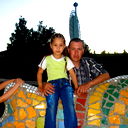The Ladybird life cycle is similar in many species, the adults overwinter often in large groups in any place they can find that is dry and if possible out of the wind. Breeding generally begins in May, but is dependant on the weather, and in most cases the presence of food. Egg laying continues on into July with each female laying as many as 1 000 eggs in some species. Many of the carnivorous species lay their eggs near aphids, ensuring their young a supply of food . Eggs take about 4 days to hatch depending on temperature, ranging from 10.3 days at 15C to 1.8 days at 35C.
The larvae moult 3 times (that is they have 4 instars) and after about 3 months depending on the density of aphids they pupate. The larvae when small are often smaller than the aphids they are eating and it is not uncommon to see a large aphid carrying a small Ladybird larva around on tis back. A 7 Spot Ladybird larva will consume more than 300 aphids before it pupates.
The prepupal stage (the time between when the lava ceases eating and attaches itself to the substrate and when it actually becomes a pupa in a pupal skin) looks hunched, in most cases the larval skin is shed as the larva becomes a pupa but remains wrapped around the posterior (tail) end of the pupa which is attached to the substrate. Though the pupa is attached at one end and in a state of morphological change it is not always immobile and will flick its anterior (head) end up and down if annoyed, this action possibly evolved as a deterrent to Hymenopteran pupal parasites, making it difficult for them to oviposit (lay their eggs).
Emergence generally occurs after about one week depending on temperature. The pupal skin splits along the back and the adult climbs out, then rests while expanding and drying its wings. The elytra are a pale yellowy-orange at this stage but soon brighten up after a few hours or days. The new adults then feed for a few weeks before dispersing and finding an overwintering site. Most Ladybirds are univoltine (having one generation per year) but some, such as the 2 Spot Ladybird (Adalia 2-punctata) and the 14 Spot Ladybird (Propylea 14-punctata) may be semivoltine (having 2 generations per year).
--------
Краткий перевод:
Стадия яйца длится около 4 дней (в среднем)
Личинка линяет трижды, стадия длится около 3 месяцев
Выход из куколки происходит обычно через неделю после окукливания
Молодые коровки некоторое время кормятся, потом уходят на зимовку.
Прочая живность
через какое время из личинки рождается взрослая божья коровка?
Похожие вопросы
- Божья коровка
- Домик для Божьей коровки...
- Почему Божья коровка названа именно так?
- Почему ничем непримечательного жучка назвали "божьей коровкой"? Почему именно "коровкой", да и при том "божьей"?
- Сколько пищи в день съедает божья коровка?
- У меня недавно завелась божья коровка...Живёт в комнате 2 дня.. Она просто удивительное существо..
- А почему божью коровку так назвали? назвали именно божьей, да еще и коровкой? почему?
- Почему Божью Коровку называют "Божьей Коровкой"?
- Что делать с божьей коровкой?
- Божьи коровки Что будет если укусит божья коровка скажите пожалуйста

